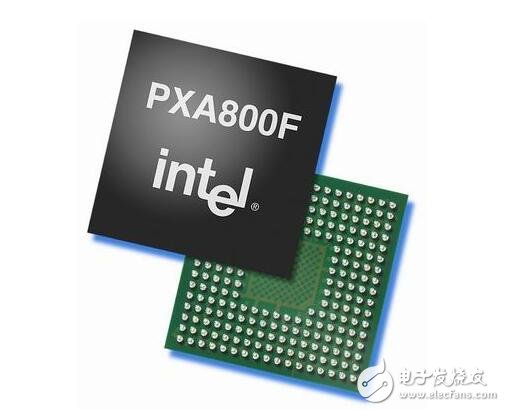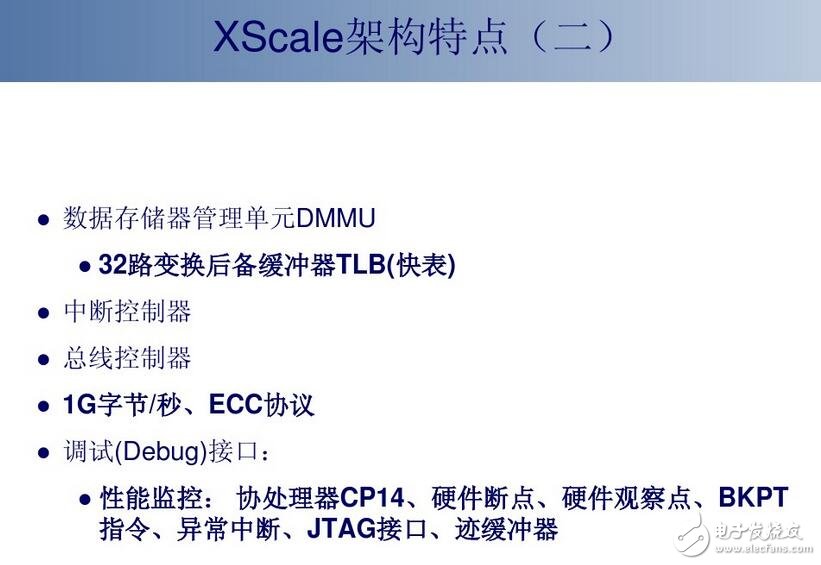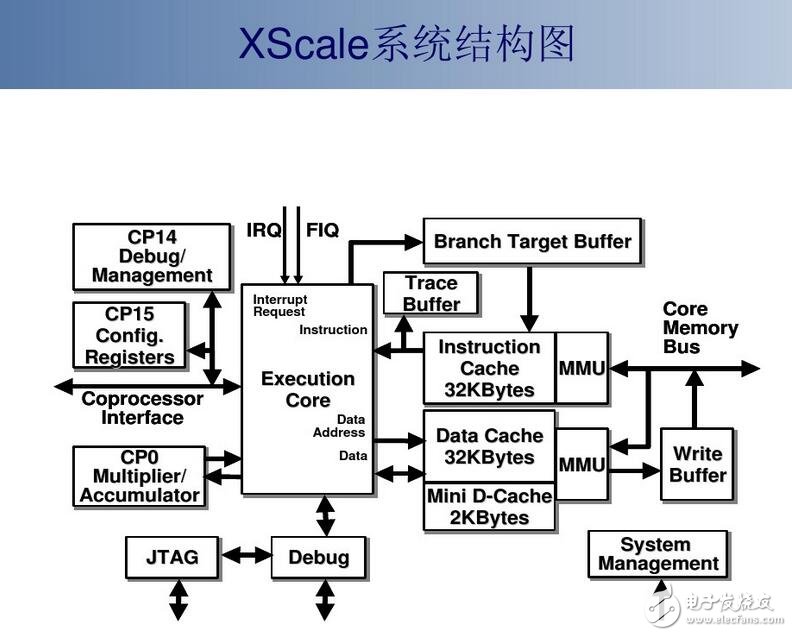Intel's XScale is derived from the ARM core and is based on this architecture, which retains backward compatibility with previous products. The Intel XScale architecture provides a new, cost-effective, low-power, ARM-based 5th generation architecture - ARMv5TE architecture solution, compatible with the ARMv5TE ISA instruction set (not supporting floating point instruction sets), support 16-bit Thumb instructions and DSP extensions.

In the field of PDA, Intel's StrongARM and XScale processors occupy a pivotal position. Both of them are ARM systems in architecture, which is equivalent to ARM's practical application. It was the product that Intel started with ARM v5TE processor. After ARM introduced the embedded core, DEC obtained the license and developed an enhanced version of StrongARM processor. Later, DEC was merged by Compaq. The StrongARM core was bought by Intel, and the SA1110 processor belonging to the system was used for a long time in the Pocket PC (one of the PDAs, using the Windows CE operating system). However, the SA1100's integration is low, many functions must be implemented with third-party chips, and there are some old-fashioned outdated interfaces and functions that are not useful. Intel improved it after taking over, and officially in February 2002. Introducing the next generation architecture based on StrongARM - XScale.
XScale processor architecture

XScale processor architecture features


XScale processor structure

XScale processor related instructions
In the instruction set structure, XScale still belongs to ARM's "V5TE" system, which is the same as ARM10 series core, but it has a distinctive 7-stage pipeline, except for the inability to directly support Java decoding and V6 SIMD instruction set. Closer to the ARM11 core. Combined with Intel's technological advantages in semiconductor manufacturing, XScale has achieved tremendous performance gains, with a maximum frequency of 1 GHz and maintaining the low power consumption of the ARM system. Coupled with rich software support, powerful expansion capabilities and add-on features, and Intel's huge influence in the industry, XScale is widely used in Pocket PC and Palm platform PDA products, becoming the factual master in this field. Other semiconductor manufacturers (such as Sony, Samsung) ARM-based solutions have a certain market, but in this field is not an opponent of Intel XScale, even Motorola that relied on the DragonBall processor to become the overlord is also unable to counterattack.
XScale processor development status
So far, Intel has introduced embedded processors for the PXA25x, PXA26x and PXA27x three-generation XScale architectures. The PXA25x is manufactured in a 0.18 micron process with a 32KB instruction cache and a 32KB data cache, and has a 2KB cache dedicated to multimedia data streams. PXA25x integrates extremely powerful functions, supports 4 Bank structure, 100MHz SDRAM memory or flash memory with up to 256MB capacity, 16-bit and 32-bit wide bus connection; PCMCIA, CF card controller and MMC/SD memory card control with dual Bank structure Integrated LCD display controller, supports up to 16-bit color display, and has certain hardware acceleration functions such as geometric filling and rectangular unit conversion; supports AC97 audio, USB, Bluetooth and infrared interfaces. The PXA25x series is available in three frequency versions of 200MHz, 300MHz and 400MHz. The chip package size is only 17 & TImes; 17mm. Due to the powerful extension capabilities of the processor itself, the design work of PDA vendors has become very simple. At present, more than 90% of the functions of PDAs or smart phones are directly integrated by the processor, and the manufacturer does not need to carry out additional design, which is the benefit of high integration.
In contrast, the PXA26&TImes; series can only be regarded as an extension of the PX25x. The core design and function expansion of the two are identical. The difference is that the PXA26x series directly integrates the flash memory in the processor. A complete PXA26x product consists of one processing core and one or two flash chips, corresponding to a 16MB, 32MB flash configuration, which saves 56% and 65% space respectively compared to traditional split packaging solutions. However, the onboard flash memory will also occupy one of the six banks. If the system integrates 4 banks, 256MB SDRAM, then only one bank can be used for CF/PCMCIA slots or other similar devices. But in general, the high integration of the PXA26x makes it ideal for the practical needs of PDAs and smartphones that pursue portability. After the launch, it has received enthusiastic response from the market and still holds a dominant position.
The PXA27x series is Intel's current flagship product, which was released in April 2004. The biggest improvement of the PXA27x is the 0.13-micron manufacturing process, which increases the clock frequency to a high level of 624MHz. Secondly, the PXA270x introduces Intel's wireless MMX technology for the first time. It is a 64-bit SIMD instruction set that effectively enhances the processing efficiency of video, 3D graphics, audio and other SIMD elements, and significantly improves multimedia processing performance.
According to Intel's official data, the 312MHz PXA270 (the lowest frequency model in the PXA27x series) has the same multimedia processing performance as the 520MHz ARM processor, while the 624MHz high-frequency PXA270 is comparable to the 775MHz ARM processor. This means that the PXA27x, which does not use the V6 instruction set, is still among the best in embedded products. Although the wireless MMX is not compatible with SSE and SSE2 on the PC, they are quite similar in function. The programmer does not have to rewrite the algorithm or program instructions. Simply adjust the calculation accuracy and data representation to make the software wireless. MMX optimization, and this work can be done in a short time.
Prospects
According to Intel's official data, the 312MHz PXA270 (the lowest frequency model in the PXA27x series) has the same multimedia processing performance as the 520MHz ARM processor, while the 624MHz high-frequency PXA270 is comparable to the 775MHz ARM processor. This means that the PXA27x, which does not use the V6 instruction set, is still among the best in embedded products. Although the wireless MMX is not compatible with SSE and SSE2 on the PC, they are quite similar in function. The programmer does not have to rewrite the algorithm or program instructions. Simply adjust the calculation accuracy and data representation to make the software wireless. MMX optimization, and this work can be done in a short time.
Since 2006, Intel has gradually cleared the communications chip business. At the time, Intel transferred the mobile phone chip business to Marvell Technologies for $600 million. Marvell introduces the PXA3xx family with a new generation of XScale architecture, with the PXA320 running at up to 806MHz.
New Arrival Linear LED Driver(Slim Driver)
Fahold has been specializing in LED Driver for 10 years. This new arrival linear led driver version, is combination of new market needs and fahold's powerful techniology.
This new version led linear drivers, has completely new function compare to fahold old one, it is much cost-effective, and adding Dali dimming; output current changeable by dip switch.
Dimming Linear Driver,Switching Power Supply, Linear LED Driver
ShenZhen Fahold Electronic Limited , https://www.fahold.com